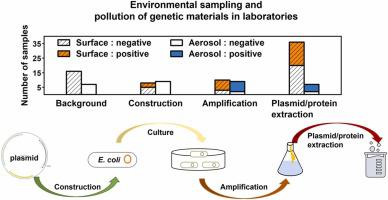当前位置:
X-MOL 学术
›
J. Hazard. Mater.
›
论文详情
Our official English website, www.x-mol.net, welcomes your feedback! (Note: you will need to create a separate account there.)
Persistent pollution of genetic materials in a typical laboratory environment
Journal of Hazardous Materials ( IF 13.6 ) Pub Date : 2024-04-02 , DOI: 10.1016/j.jhazmat.2024.134201 Xue Li , Ce Liu , Dongbin Wang , Jianguo Deng , Yuntao Guo , Yicheng Shen , Shuwen Yang , John S. Ji , Haiyun Luo , Jingwei Bai , Jingkun Jiang
Journal of Hazardous Materials ( IF 13.6 ) Pub Date : 2024-04-02 , DOI: 10.1016/j.jhazmat.2024.134201 Xue Li , Ce Liu , Dongbin Wang , Jianguo Deng , Yuntao Guo , Yicheng Shen , Shuwen Yang , John S. Ji , Haiyun Luo , Jingwei Bai , Jingkun Jiang

|
From the onset of coronavirus disease (COVID-19) pandemic, there are concerns regarding the disease spread and environmental pollution of biohazard since studies on genetic engineering flourish and numerous genetic materials were used such as the nucleic acid test of the severe acute respiratory syndrome coronavirus (SARS-CoV-2). In this work, we studied genetic material pollution in an institute during a development cycle of plasmid, one of typical genetic materials, with typical laboratory settings. The pollution source, transmission routes, and pollution levels in laboratory environment were examined. The Real-Time quantitative- Polymerase Chain Reaction results of all environmental mediums (surface, aerosol, and liquid) showed that a targeted DNA segment occurred along with routine experimental operations. Among the 79 surface and air samples collected in the genetic material operation, half of the environment samples (38 of 79) are positive for nucleic acid pollution. Persistent nucleic acid contaminations were observed in all tested laboratories and spread in the public area (hallway). The highest concentration for liquid and surface samples were 1.92 × 10 copies/uL and 5.22 × 10 copies/cm, respectively. Significant amounts of the targeted gene (with a mean value of 74 copies/L) were detected in the indoor air of laboratories utilizing centrifuge devices, shaking tables, and cell homogenizers. Spills and improper disposal of plasmid products were primary sources of pollution. The importance of establishing designated experimental zones, employing advanced biosafety cabinets, and implementing highly efficient cleaning systems in laboratories with lower biosafety levels is underscored. . Persistent environmental pollutions of genetic materials are introduced by typical experiments in laboratories with low biosafety level.
中文翻译:

典型实验室环境中遗传物质的持续污染
自冠状病毒病(COVID-19)大流行以来,由于基因工程研究的蓬勃发展以及大量遗传材料的使用(例如严重急性呼吸系统综合症冠状病毒的核酸检测),人们对疾病传播和生物危害的环境污染感到担忧(SARS-CoV-2)。在这项工作中,我们在典型的实验室环境下研究了一家研究所在质粒(典型遗传物质之一)的开发周期中遗传物质污染。检查了实验室环境的污染源、传播途径和污染程度。所有环境介质(表面、气溶胶和液体)的实时定量聚合酶链式反应结果表明,随着常规实验操作,目标 DNA 片段发生了。在遗传物质操作中采集的79个地表和空气样本中,一半的环境样本(79个中的38个)核酸污染呈阳性。所有检测实验室均观察到持续性核酸污染,并在公共区域(走廊)蔓延。液体和表面样品的最高浓度分别为 1.92 × 10 拷贝/uL 和 5.22 × 10 拷贝/cm。使用离心设备、摇床和细胞匀浆器在实验室的室内空气中检测到大量目标基因(平均值为 74 拷贝/升)。质粒产品的溢出和处置不当是主要污染源。强调了在生物安全水平较低的实验室建立指定实验区、采用先进生物安全柜和实施高效清洁系统的重要性。 。生物安全水平较低的实验室典型实验造成遗传物质的持续环境污染。
更新日期:2024-04-02
中文翻译:

典型实验室环境中遗传物质的持续污染
自冠状病毒病(COVID-19)大流行以来,由于基因工程研究的蓬勃发展以及大量遗传材料的使用(例如严重急性呼吸系统综合症冠状病毒的核酸检测),人们对疾病传播和生物危害的环境污染感到担忧(SARS-CoV-2)。在这项工作中,我们在典型的实验室环境下研究了一家研究所在质粒(典型遗传物质之一)的开发周期中遗传物质污染。检查了实验室环境的污染源、传播途径和污染程度。所有环境介质(表面、气溶胶和液体)的实时定量聚合酶链式反应结果表明,随着常规实验操作,目标 DNA 片段发生了。在遗传物质操作中采集的79个地表和空气样本中,一半的环境样本(79个中的38个)核酸污染呈阳性。所有检测实验室均观察到持续性核酸污染,并在公共区域(走廊)蔓延。液体和表面样品的最高浓度分别为 1.92 × 10 拷贝/uL 和 5.22 × 10 拷贝/cm。使用离心设备、摇床和细胞匀浆器在实验室的室内空气中检测到大量目标基因(平均值为 74 拷贝/升)。质粒产品的溢出和处置不当是主要污染源。强调了在生物安全水平较低的实验室建立指定实验区、采用先进生物安全柜和实施高效清洁系统的重要性。 。生物安全水平较低的实验室典型实验造成遗传物质的持续环境污染。



























 京公网安备 11010802027423号
京公网安备 11010802027423号